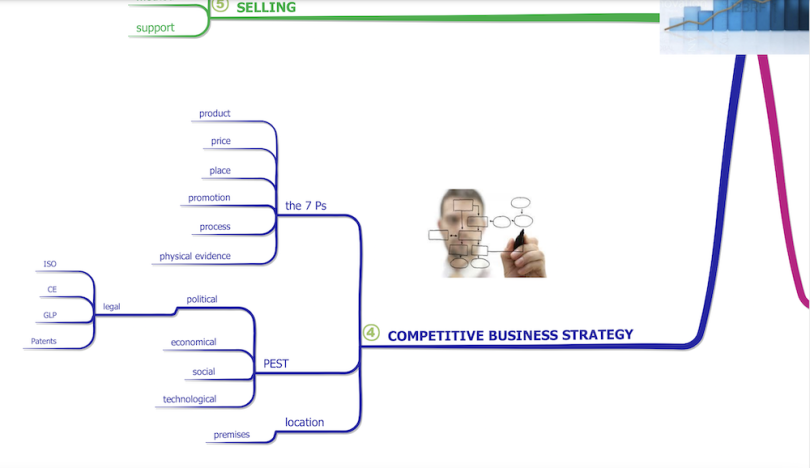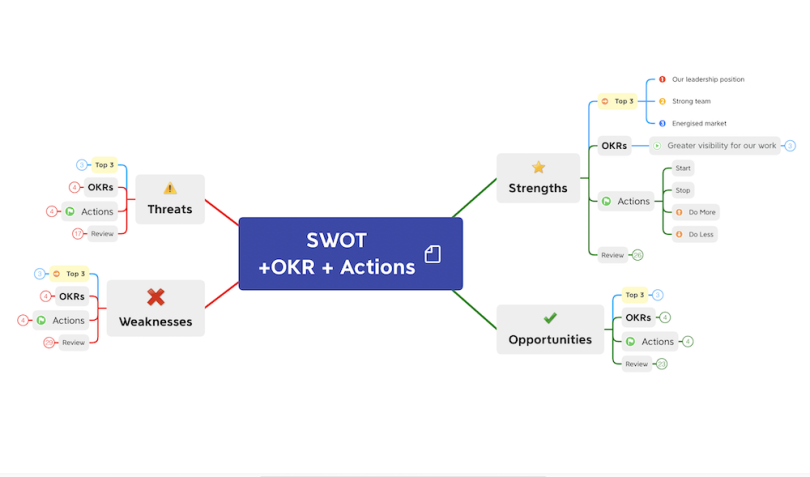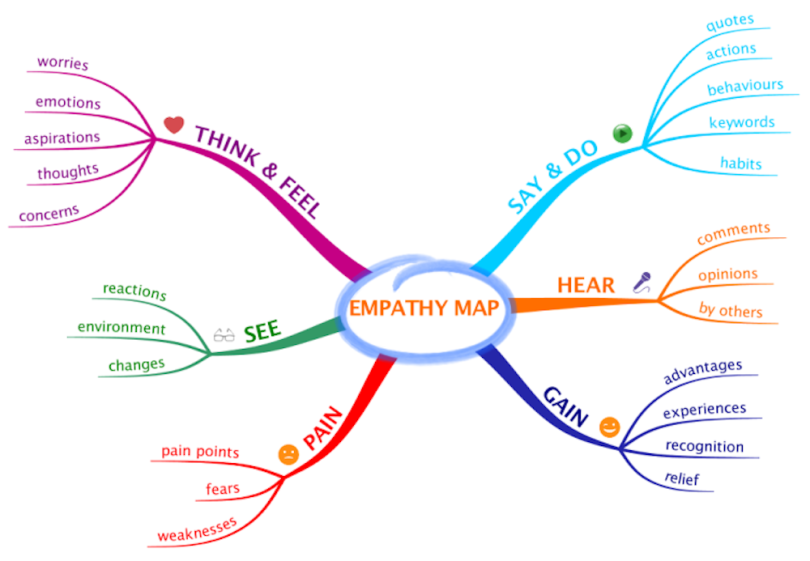For a technique that’s all about logical flow, mind mapping took a circuitous path to the business world.
The information diagram — in which multiple nodes branch from a central topic, creating a radial, hierarchical structure — was created and popularized as a personal note-taking and memory-aide system in the early seventies.
But it wasn’t until decades later that users realized that applied better to a number of aspects of contemporary work, including project management, product roadmapping and marketing, and strategic planning systems, like SWOT analysis — an outline of strengths, weaknesses, opportunities and threats. The addition of multi-user collaboration to many of the software options in recent years has broadened the technique’s appeal further still.
7 Business Use Cases for Mind Mapping
- Program evaluation
- Business planning
- Product launches
- SWOT analysis and strategy mapping
- Project management
- Personal organization
- Customer profiling
“SWOT analysis, PESTLE analysis, the seven Ps of marketing, any kind of brainstorming processes — all absolutely belong, in my view, in any kind of mind-mapping software,” said Liam Hughes, founder of Biggerplate, a community and library of mind-mapping examples and templates.
As a longtime mind-mapping consultant and proprietor of the site, which was founded in 2007, Hughes has seen more mind maps than even most of his fellow enthusiasts. So we asked him to choose a few examples from the archives that illustrate the technique’s power in business contexts and to lend a bit of advice for how the uninitiated can get the most out of each.
This story is part of a series about mind mapping.

Program Evaluation
In 2016, while Hughes was doing consulting for the Centers for Disease Control and Prevention, one CDC member realized that the agency’s framework for evaluating completed programs — a smoking cessation initiative or opioid intervention measure, for instance — might be easier to engage with if it were filtered through a mind-mapping lens. The framework itself (a wide-ranging, six-stage assessment) was solid, it was just a lot to take in.
“You had this really robust process with really great documentation but people also found it quite overwhelming,” said Hughes.
Biggerplate worked with the CDC to create an individual mind map template for each stage of the agency’s evaluation process: engaging stakeholders, describing the program, focusing the evaluation design, gathering credible evidence, justifying conclusions and sharing lessons learned. The maps weren’t intended to replace a formal write-up but aid the process and live on as a document of that process as well.
Each template also lives on Biggerplate, since the agency’s framework and the individual mind maps, might be useful for any organization that needs to analyze a project or policy.

Business Planning
Mind maps tend to work well for uses that involve hierarchical relationships, which means it’s a natural fit for business planning. The above close-up of a planning mind map is a good example. Note the branches moving from “patents” to “legal” to “political” to the PEST (political, economic, social and technological) analysis management method.
The format makes it easy to think about each step holistically but what might be less obvious to newcomers is that it can also serve as the project’s knowledge repository. In templates like the one linked here, users can add key links and attachments to each node as well as checkboxes that you can mark as tasks are completed, to track overall progress.
Hughes highlighted that map for another reason: It’s not much to look at. Even though Tony Buzan, the creator of mind mapping, emphasized the use of color and icons, and many of the popular mind-mapping tools now sport handsome user interface designs, people curious about applying the technique to their work shouldn’t let aesthetic anxieties get in their way.
“It’s not about pretty colors or images,” Hughes said. “It’s about organizing ideas and information.”

Product Launch
Every product or feature launch relies on some manner of visual diagramming, like Kanban-style progress tracking or Gantt-style timelines for big-picture prioritization. Several mind mapping tools now incorporate those and other launch-friendly views but plenty of users maintain that the mind map structure itself is a good fit for launch planning and execution.
A product launch template made by MindMeister user Raphi Brand and shared on Biggerplate is a good starting point for brainstorming each section and stage of the launch roadmap, Hughes said. Nodes for social media, company blog, in-app notification, email marketing and other facets stem from the central launch hub.
Dropping in checklist details — like the task information breakdown for a newsletter pictured in the template close-up above — can help bridge the planning and action stages of the launch.

SWOT Analysis and Strategy Mapping
If Biggerplate’s collections and consulting work are any indications, SWOT analysis has been an evergreen concern for mind mapping for years. Users have shared more than 100 templates and examples on the site, and Hughes hosts workshops on how to best approach SWOT mind maps while also walking through the process directly with clients.
Templates are often left intentionally bare-bones since category specifics can vary significantly between business types. Hughes recommended the one pictured above (and available here) as a good middle ground — it’s scaled back enough to be broadly applicable but with added nodes (“top 3,” “OKRs,” “actions” and “review”) to better kickstart the process.
For SWOT mind mapping, Hughes recommends a three-step process: capture, categorize and prioritize. That essentially means brain-dump your ideas, then fit each into a manageable category, then rank what’s most important.
Doing so in a mind map, as opposed to in person, helps streamline the process and makes the end results clearer, Hughes said.
“If you speak to most people who’ve had consultants who come in and do SWOT analysis, they have flip charts or a wall full of post-its. Then some poor bastard has to go and write it all up, which is fraught with all kinds of interpretation and bias and confusion,” Hughes said. The real-time editing of mind maps, on the other hand, helps clarify ideas and serve as an easily accessible record of the session.

Project Management
Project management likely ranks among the top three most popular business-related topics for mind mapping, Hughes said, based on his experience running Biggerplate. Indeed, some makers of mind-mapping software have evolved their products to better facilitate project management within the tool, from XMind’s timeline templates to MindMeister’s multi-stakeholder-friendly real-time collaboration.
Above is one of Biggerplate’s most viewed and downloaded project management maps, a diagram of the 10 knowledge areas that make up the Project Management Body of Knowledge guidelines. Experienced project managers will know the principles front to back, but they still report that having an adaptable template is helpful for organizing new projects, while students studying for Project Management Professional certification often find such diagrams to be study aids, Hughes said.

Personal Organization and Productivity
Hughes told Built In that he’s noticed a recent spike in interest in mind mapping, a trend he suspects may have something to do with its potential as a remote collaboration and brainstorming tool. That’s a very real selling point for software that does support multi-user work but mind mapping remains useful for solo organization and productivity.
Above is an insert of this personal organization example, created by Biggerplate, which stems off nodes for customers, projects, marketing and personal planning. Each has space for notes, hyperlinks and attachments, meaning users can centralize tasks into one document, if they like.
That can help users flesh out tasks too, rather than simply track them. “Tools like Trello are fantastic but they don’t really help you understand the context of a task — just a task in isolation. Whereas here I can add a date, who [a task] is assigned to, a document link and can mark what’s been done or not,” he said.
To get the most out of personal productivity mind mapping, Hughes suggests what he calls “around-the-clock” prioritization — our focus naturally drifts to the top-right, so place the most important nodes (customers, in this instance) there — and “top-to-bottom” prioritization — stacking more important nodes above lower-priority ones. Alpha, in this template, is a higher-priority firm than Bravo or Foxtrot. Also consider what Hughes calls a “fixed first branch,” an ever-present, easily visible node that highlights major goals to ensure they don’t fall from focus.

Customer Profiling and Empathy Mapping
So much of what broadly falls under the category of customer profiling — persona building, empathy mapping, design thinking stages — tends to flow better when dropped into some form of information diagram, like outlines summaries or quadrant maps. Users have found similar value in the mind map structure, too.
The above template is one of several available that simply transport the traditional empathy map process into a radial, hub-and-spoke presentation. But because mind maps are also tailor-made for ranking hierarchical information, product managers, in particular, might find them useful if asking users to weight their feelings and observations, as opposed to a looser collection of notes.




